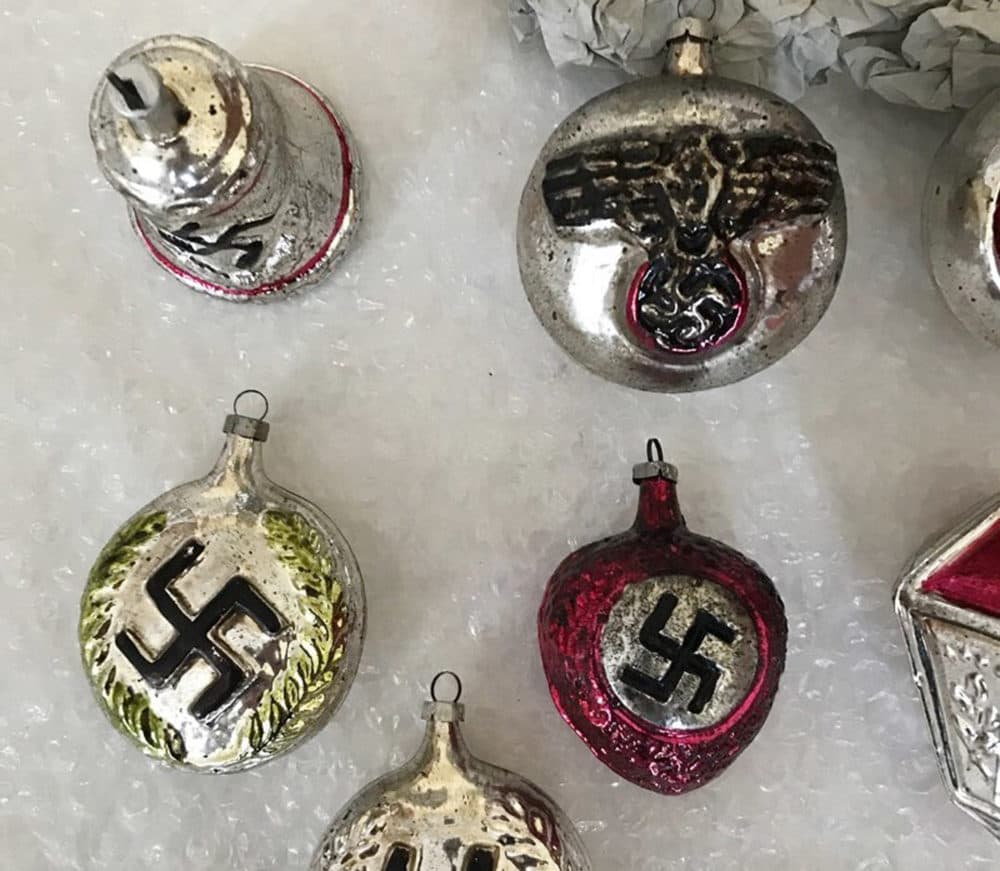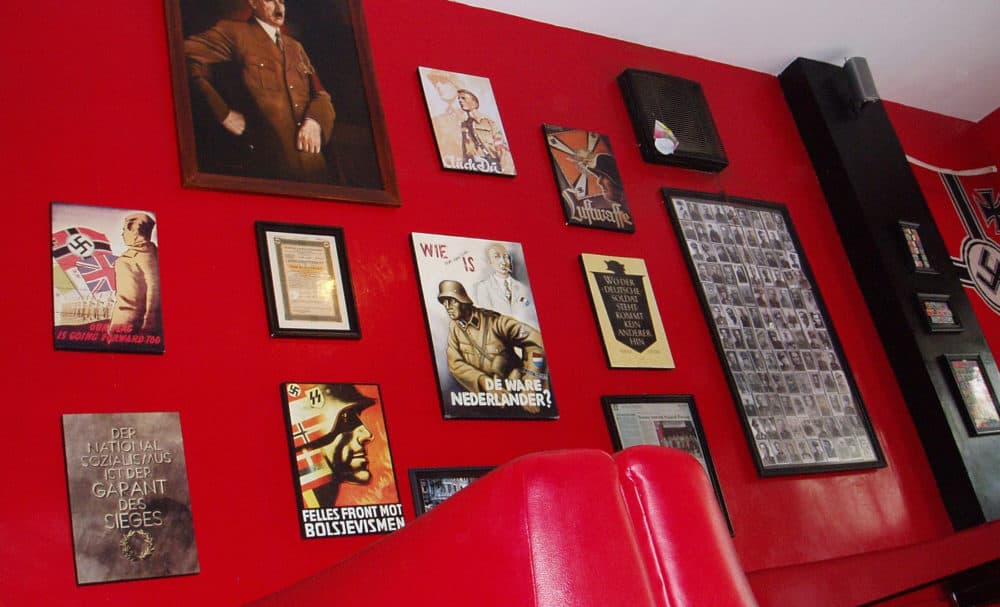Advertisement
Commentary
I Went To A Nazi Memorabilia Auction. Here's What I Saw

I recently read about the rise in the sale of Nazi memorabilia. Artifacts — photos of Hitler, rings, armbands displaying a swastika — are being sold at auction for thousands of dollars. The Washington Post reported Hitler’s telephone, from his bunker, being sold at auction for $243,000, for example.
The Post quoted Terry Kovel, one of the country’s best known experts on antiques, saying, “The market for historic Nazi memorabilia is definitely growing. A lot of people are afraid the whole Nazi thing has been forgotten.”
I should have been shocked at that news. But my wife and I had just returned from such an auction, down the road from our house.
How did we find ourselves in an auction of Nazi memorabilia just days before Christmas?
A few weeks earlier, we had stopped in a local collectibles shop thinking we might find a painting to hang in our new home in Gloucester, on Boston’s North Shore. Nothing stood out, but the owner suggested we come to an estate auction he was having in December.

On the afternoon of the auction, my wife, Naomi Schalit, went to the auctioneer’s website to see if there would be anything for sale that interested us. Instead of seascapes or antique maps, she saw dozens and dozens of Nazi items, including photos of Hitler.
You don’t need a personal connection to World War II or the Holocaust to be disgusted, but we both had such connections. Naomi is Jewish; some of her family members were murdered in the Holocaust. I have spent the last few years working on a memoir about growing up in a family traumatized by the first genocide of the 20th century, the murder of 1.5 million Armenians by the Ottoman Empire, including my grandmother’s parents.
The two cataclysmic events are connected: When Hitler was asked how he expected to get away with the extermination of Europe’s Jews, his response was, “Who, after all, speaks today of the annihilation of the Armenians?"
Rows of folding chairs in the middle of the room were ringed by tables and shelves jammed with Nazi memorabilia.
At first, we decided not to go to the auction, then, half an hour later, we changed our minds. We are both journalists. At a time when anti-Semitic and other hate crimes are on the rise, we thought the event needed documenting.
We parked our car at the back end of a small industrial park near Gloucester’s border with Manchester-by-the-Sea. We stepped through a metal door and walked down a wooden staircase into a high-ceilinged basement room.
Rows of folding chairs in the middle of the room were ringed by tables and shelves jammed with Nazi memorabilia.
Minutes later, we joined 30 or so older white men and a few women who were noting the lot numbers they wanted to bid on once the auction began.
There were helmets, stick pins, insignias, badges, daggers, medals, flags, books and magazines, all emblazoned in some way with a swastika or the Nazi eagle or a combination of both.
It was all disturbing, but lot no. 181 turned my stomach. Inside the glass case were a half dozen armbands, including two with the Star of David and one from the Nazi extermination camp, Auschwitz-Birkenau.
A middle-aged man in a Grand Tetons national park baseball cap inspected a helmet. A man with a three-day stubble was petting his tiny dog, which was dressed in a plaid sweater. In the back row, a woman munched on a cookie while she waited for the auction to start.
My bile was rising, but the reporter in me forced it down. Keep observing, take notes.
The back of the room held a glass case that pushed me over the edge. All the Nazi items had been neatly organized in their cases. This case, though, was a jumbled mess of American military items — Navy stripes, Army infantry badges, small U.S. flags.
My father fought in WWII. My uncle’s ship was torpedoed by a Nazi U-boat in the Norwegian Sea; he waited hours in the icy seas to be rescued. He died a decade later after being institutionalized with PTSD.
I had to say something. I noted, to two women standing nearby, the unseemly juxtaposition of pieces taken from the uniforms of Americans who had fought the Nazis, with the respectfully displayed items from the men who tried and, in many cases, succeeded in killing them.
“Oh yes,” one of the women replied. “It’s because the collector wanted to show both sides of the story so people won’t forget.”
I said we don’t need a Nazi armband to remember World War II and asked where the collection came from.
It’s from a man in Quincy, they both said, and pointed me to the auctioneer if I had more questions. A thin man in a sport shirt, he was sorting through some material when I asked him the question that had been nagging at me.
“Have you considered,” I said, “the morality of making money from selling Nazi memorabilia?"
He gave me the same answer the women did, as if they had rehearsed it: “This is just history that tells both sides of the story.”
Hadn’t I heard those words a little more than year ago? That was after the neo-Nazi march in Charlottesville, Virginia and President Trump reacted: "You had some very bad people in that group, but you also had people that were very fine people, on both sides."
“Have you considered,” I said, “the morality of making money from selling Nazi memorabilia?"
I repeated my question, more forcefully this time.
“Get out,” he said. “Get out of here now.”
He walked inches behind me as I went up the stairs and out the door. But Naomi was still in the auction, where she stayed and took notes on the sales, such as one buyer who paid $200 for a Nazi helmet.
When she came out, she told me what upset her the most. On one of the tables, she saw a wooden handle, like you might see on a bell. She picked it up and turned it over. On the bottom was a swastika. She had picked up a metal stamp, the sort of device a Nazi bureaucrat would have used.
She dropped it right away.
“I realized that I was holding something that had once been held by a Nazi,” she said. “It might have been used to stamp papers to send Jews to their death.”
When we came home we both washed our hands.
But we couldn’t wipe our minds clean of the memory of a room full of people eager to bring home souvenirs of one of the greatest horrors in human history.
Editors' Note: Cognoscenti attempted to contact the North Shore auction owner before publication of this commentary. After it was published, the auction owner denied that he or his staff member said the memorabilia “tells both sides” and also denied that it was only a Nazi memorabilia auction. The auction owner, whom Cognoscenti did not identify, explained why he decided to include the items here.
This article was originally published on January 30, 2019.
